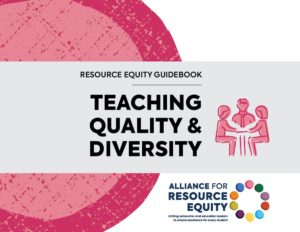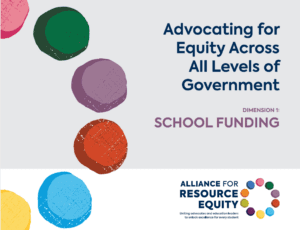The Vision
Each student—including students with higher needs and students of color—has access to strong school leadership from principals and instructional leadership teams who meet their needs, so all students can reach high standards and thrive. The school leadership workforce reflects students’ racial and linguistic diversity.
Sample Questions to Ask
- What percentage of schools in our district have stable school leadership teams (the same school leadership over a three-year period)?
- How does the stability of school leadership vary across schools in our district?
- How diverse is the school leader pipeline (relative to the student and staff populations of our district)?
- Do retention rates differ for school leaders of color and linguistically diverse school leaders, compared to other school leaders?
Take Action With Our Diagnostic Tools
- Use our Resource Equity Diagnostic: Self-Assessment tool to start conversations and build shared understanding across teams.
- Then, analyze your data to better understand the state of resource equity in your district. First, use our Diagnostic Blueprints to learn about what types of analyses to conduct. Then, input your district data into our DIY Analysis Tools to complete these analyses and make meaning of the results.
- Prioritize areas for further inquiry and identify potential root causes and actions using our District Guidebook.
Common Causes of Inequity
- Non-Strategic Assignment Practices: Because of a lack of incentives, recognition, and opportunities for growth, the strongest teachers may not find roles in the highest need schools to be attractive or sustainable.
- Poor Working Conditions: Challenging workloads or school climates without appropriate flexibilities and supports can reduce school leaders’ morale, retention and performance.
- Flawed Hiring Practices: When school leader pipelines and hiring practices are flawed and/or biased, districts can struggle to recruit a sufficiently high-potential and diverse applicant pool.
Related Dimensions
No single dimension of education resource equity can unlock every student’s potential—but when dimensions are combined to meet students’ distinct needs, they are a strong foundation for unlocking better, more equitable experiences in school.
Explore the Positive & Inviting School Climate dimension, as school leaders play an important role in developing the climate in their school building.
Toolkit
Use our Resource Equity Toolkit to learn more, start a conversation, and take action in your community.

The Education Combination
Learn about education resource equity by discovering 10 dimensions that unlock better, more equitable experiences in school for all students.

Diagnostic Tools And Supports
Identify strengths and gaps in your school system across all 10 dimensions.

Guidebooks
Explore underlying causes of your school system’s challenges and possible actions to improve students’ experiences in school.

Advocating Across Government
Identify who has the power to address equity gaps in your school system and the school district, state and federal levels.

Casemaking Decks
Develop compelling and coherent messaging to “make the case” for addressing resource inequities in your community.
